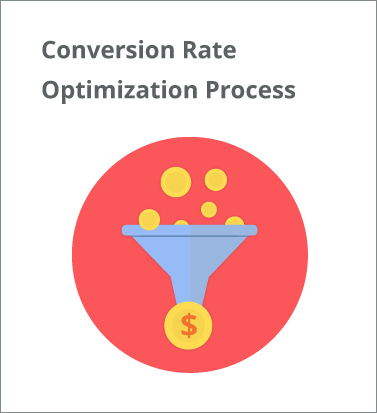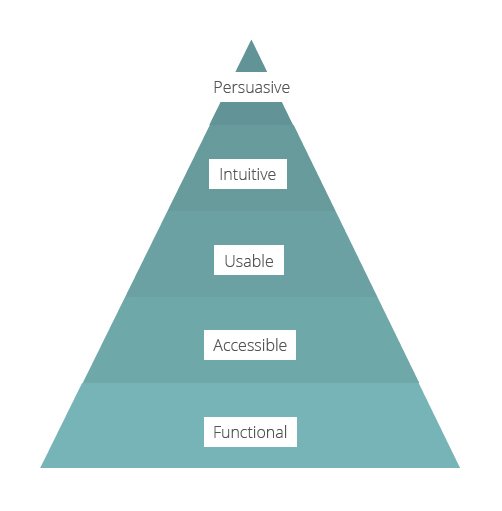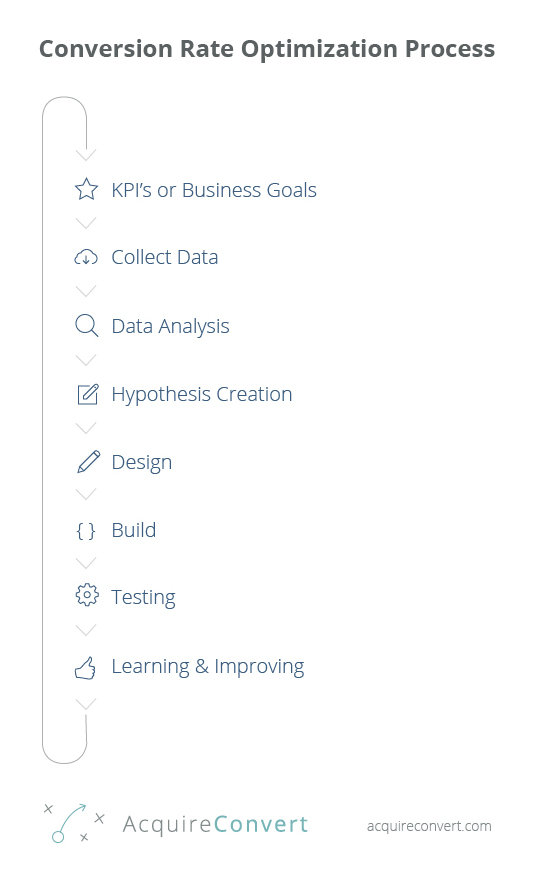Conversion Rate Optimization Process

Conversion rate optimization or CRO is all about marketing. It’s about in-depth and laser focused understanding of your customer and how to provide them with a better user experience aiding them in finishing tasks faster and in simpler and more efficient ways.
The ONLY way to achieve this is through data, no guessing, no hunches, definitely not I JUST KNOW candidates.
You must form a ‘hypothesis’ to test but before even this you must collect data, not just any data but the right data.
Bad data or drawing the wrong conclusion from good data is as useless as guessing in the first place.
It is a waste of time to test any of the hypothesis drawn from the these situations.
So a true Conversion Optimizer knows how to get good data that is actionable and knows how to analyse it to draw hypothesis from it to test.
In this case we can see that CRO is not solely about landing pages or analytics but it is about people, design, copywriting, user experience.
Another huge mistake people make is thinking just because conversions go up we have done a good job, NO. You can cut prices by 99% and see a huge leap in CR but you’ll see far less revenue and subsequently profit.
So the real goal for a CRO person is increase revenue and do so profitably. It is about better sustainable long term marketing.
In conversion rate optimization there is no one answer
People often mistakes case studies or the experience of others as de facto. But there is no single correct way to do something. You can of course over time become more attuned to huge problems, but these hunches should only be used to create inputs around data gathering. CRO is not about guesswork.
Eisenberg Brothers
Just like Maslow’s hierarchy of needs, conversion rate optimization has it’s own hierarchy. And much like Maslow the top of your totem pole of needs can only be met once the lower levels are taken care of.
1. Functional
Before we even start to consider CRO we need to get the foundation right. Does the site work? Is your traffic heavily leaning towards legacy browsers ? Tough S^&t! Optimise for them. I recommend Browser Stack for cross browser and device testing for those with no budgets for a device buying spree. Otherwise Ghostlab by Vanamco will rock your socks off! Bug fixing is easy CRO work, if a page doesn’t even display in a browser, making it so will see pretty good increases in conversions.
2. Accessible
Are you taking care of users of all skill levels, handicaps? Here is a sweet accessibility check list, tick them boxes. Readability of fonts and contrast is always a biggie here and don’t forget people who are disabled need your services too.
3. Usable
Do you meet Google’s page speed load requirements? Get their insights by running a test. Is it obvious, can users get to any page and take any action they need to with ease. Focus on the learnability and rememberability of your site.
4. Intuitive
Does your funnel and user journey match what the user expects in their mind. Reduce barriers to entry in the conversion process whether sale, opt in or free to premium conversion. In depth customer development will reveal reservations customer have at different touch points in the buying process. Address them and alleviate those concerns.
5. Persuasive
Do you communicate effectively that what you offer fills the users needs or solves their problems? Copywriting and content is the foundation of all page designs. Content first, content first, content first, then mobile.
CRO is a process
Lots of people especially when it comes to marketing say, just try lots of things and see what works.
Ok so what does that actually mean.
Do lots of small campaigns and see which ones give a return? DON’T do that please. Instead form a strategy with goals that can be measured against and learnt from.
Much like the Build > Measure > Learn cycle we are all so familiar with CRO has it’s own cycle.
1. KPI’s or Business Goals
Decide which KPI’s to track and increase
2. Collect Data
Set up google analytics and wait for the (right) data to come in
3. Data Analysis
Analyse all data and look for patterns
4. Hypothesis Creation
Develop hypothesis and rank them based on their cost and difficulty to implement. This determines the priority.
5. Design
From the hypothesis and data comes copywriting, then sketches, formal wireframes and finally the visual design.
6. Build
Time to code remembering to browser and device test.
7. Testing
A/B Testing following scientific methods with tests running until statistical significance is reached.
8. Learning & Improving
We gain new learning from the test and develop or iterate on our hypothesis
Back to step 2!
Cycles can take from 3 weeks to 9 months, mostly depending on your traffic, site complexity and how much data you have when arriving on the project.
What is a conversion?
A conversion is all about people, not numbers or statistics. It is changing the mindset of one person within the funnel from visitor to free trial or paid. Everyone needs to find their core conversions to measure.
“Conversion Rate Optimization is the process of increasing the percentage of visitors that complete a desired action within a period of time. Sign up, buy, subscribe, whatever it might be.”
At the end of the day it’s about dollars. More profitable revenue. Something your accountant probably talks about a lot!
6 Factors of Conversion Rate to keep in mind
1. Product cost
It’s easier to sell $1 razor, dollarshaveclub! Than it is to sell an private jet.
2. Trust
Does the visitor or prospect know and trust your brand. If not you have not discovered content marketing and content promotion.
3. Relevancy
The best marketing is wasted on the wrong people. Understand your users through personas and their paths to sales.
For example Pinterest is an aspirational network and tumblr is creatively biased. Understand the slang and language of the networks, which ones pertain to your audience and how to funnel them to your website.
4. Perceived Value
A jet plane becomes easier to sell if it is presented as a bargain!
5. Copywriting
Make sure your headlines talk to the needs and wants or problems of your prospects, do not waffle on about yourself. You cares. Business is about the customer not you.
6. Design and UX of your site.
What conversion rate should I have?
Well again there is no size fits all. But a good rule of thumb is better than the last time you checked. And with an iterative and planned strategy those checks should be scheduled and recorded. Monthly is a good place to start. I would shoot for 5% for the first 6 months.
Share your process and download the pack below
What is your CRO Process, share your thoughts and approaches in the comments below. I have made the CRO Process we discussed shareable below if want to include it in your website.


